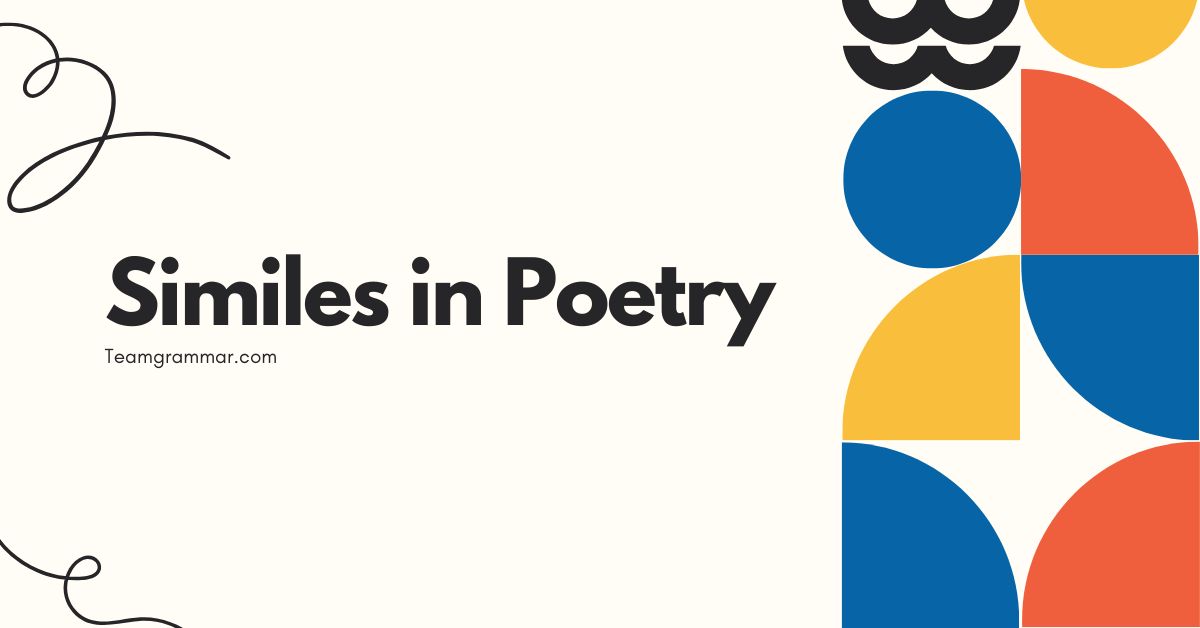39 Similes in Poetry: Definition, Examples, and Usage
Similes are a cornerstone of figurative language, enriching poetry with vivid imagery and deeper meaning. Understanding how similes function is crucial for both appreciating and crafting compelling verse.
This article provides a comprehensive guide to similes in poetry, exploring their definition, structure, types, and usage, complete with numerous examples and practice exercises. Whether you’re a student, an aspiring poet, or simply a lover of language, this guide will equip you with the knowledge to master the art of the simile and enhance your understanding of poetry.
Table of Contents
- Introduction
- Definition of Simile
- Structural Breakdown of Similes
- Types of Similes
- Examples of Similes in Poetry
- Usage Rules for Similes
- Common Mistakes When Using Similes
- Practice Exercises
- Advanced Topics in Similes
- Frequently Asked Questions
- Conclusion
Definition of Simile
A simile is a figure of speech that directly compares two different things, using the words “like” or “as.” The purpose of a simile is to create a vivid image or to emphasize a particular quality of one thing by associating it with something else that is familiar to the reader. It is a powerful tool in poetry because it allows poets to paint a picture with words and to evoke emotions through association.
Similes are distinct from metaphors, which also compare two things but do so implicitly, without using “like” or “as.” While a simile states that something is like something else, a metaphor states that something is something else. This directness of the simile makes it a clear and accessible form of figurative language.
In poetry, similes enhance the reader’s experience by adding layers of meaning and sensory details. They help to create a connection between the abstract and the concrete, making complex ideas more relatable and understandable.
The effectiveness of a simile depends on the clarity of the comparison and the relevance of the two things being compared.
Structural Breakdown of Similes
The structure of a simile typically consists of three key components: the subject (the thing being described), the linking word (either “like” or “as”), and the object of comparison (the thing to which the subject is being compared). Understanding this structure is essential for both identifying and crafting effective similes.
The basic formula for a simile is:Subject + Linking Word + Object of Comparison. For example, in the simile “Her smile was as bright as the sun,” “her smile” is the subject, “as” is the linking word, and “the sun” is the object of comparison.
This structure provides a clear and direct comparison that the reader can easily understand.
The effectiveness of a simile relies on the strength and relevance of the comparison. The object of comparison should have a quality that is shared with the subject, and this shared quality should be the focus of the simile.
For instance, in the example above, the shared quality is brightness. The simile works because the sun is widely recognized as being bright, and this brightness is being used to describe the smile.
Similes can also be extended or elaborated upon to create a more complex and nuanced comparison. This might involve adding additional details or qualifiers to either the subject or the object of comparison.
However, it’s important to maintain clarity and avoid making the simile too convoluted or confusing.
Types of Similes
Similes can be categorized based on the type of comparison they make and the effect they create. Understanding these different types can help poets and writers choose the most effective simile for their purposes.
Descriptive Similes
Descriptive similes focus on providing a vivid description of the subject by comparing it to something else with a similar quality or characteristic. These similes are often used to create a strong visual image in the reader’s mind.
Figurative Similes
Figurative similes create an imaginative comparison between two things that are not literally alike. These similes often rely on abstract concepts or emotions to make the comparison.
Humorous Similes
Humorous similes are used to create a sense of humor or irony by comparing two things in an unexpected or absurd way. These similes can be a powerful tool for satire and social commentary.
Extended Similes
Extended similes, also known as Homeric similes (named after Homer, who frequently used them), are longer and more detailed similes that develop the comparison over several lines or even an entire stanza. They often provide a more elaborate and descriptive comparison than simple similes.
Examples of Similes in Poetry
The following examples illustrate the various types of similes used in poetry, showcasing their versatility and effectiveness in creating vivid imagery and conveying meaning.
Table 1: Descriptive Similes in Poetry
The table below showcases descriptive similes, which aim to paint a vivid picture by comparing a subject to something with a shared tangible quality.
| Simile | Analysis |
|---|---|
| “The moon was like a silver coin in the night sky.” | Compares the moon’s shape and color to a familiar object, emphasizing its brightness and roundness. |
| “Her hair was as dark as a raven’s wing.” | Highlights the deep black color of the hair by associating it with a raven’s wing. |
| “The snow fell like feathers from the sky.” | Emphasizes the lightness and gentle descent of the snow. |
| “His voice was as smooth as velvet.” | Describes the pleasant texture of the voice, suggesting a soothing and comforting quality. |
| “The leaves were like golden coins scattered on the ground.” | Creates a visual image of autumn leaves, emphasizing their color and abundance. |
| “The river flowed as smoothly as glass.” | Highlights the calm and undisturbed nature of the river’s surface. |
| “Her eyes were like emeralds, sparkling with light.” | Compares the color and brilliance of the eyes to precious gemstones. |
| “The wind howled like a wolf in the night.” | Emphasizes the ferocious and mournful sound of the wind. |
| “The city was as busy as a beehive.” | Highlights the bustling and energetic nature of the city. |
| “The cake was as light as air.” | Describes the delicate texture of the cake, suggesting it is fluffy and not dense. |
| “His skin felt like sandpaper.” | Emphasizes the rough texture of the skin. |
| “The coffee was as black as night.” | Highlights the deep, dark color of the coffee. |
| “The silence was like a heavy blanket.” | Describes the oppressive and stifling quality of the silence. |
| “The dew drops glistened like diamonds on the grass.” | Emphasizes the sparkle and beauty of the dew drops. |
| “The old house stood as still as a statue.” | Highlights the motionless and silent nature of the house. |
| “The clouds were like cotton candy in the sky.” | Creates a whimsical image of fluffy, white clouds. |
| “Her laughter was like music to his ears.” | Describes the pleasant and melodious sound of her laughter. |
| “The sun beat down like a hammer on the roof.” | Emphasizes the intense heat and force of the sun. |
| “The rain fell like tears from the sky.” | Connects the rain with a feeling of sadness or sorrow. |
| “The forest was as quiet as a tomb.” | Highlights the profound silence of the forest. |
| “The bread was as hard as a rock.” | Emphasizes the solid and unyielding texture of the bread. |
| “His muscles were like steel cables.” | Describes the strength and resilience of his muscles. |
| “The fog hung in the air like a ghostly shroud.” | Creates an eerie and mysterious atmosphere. |
| “Her touch was as light as a feather.” | Highlights the gentle and delicate nature of her touch. |
| “The stars twinkled like diamonds scattered across black velvet.” | Emphasizes the brilliance and arrangement of the stars. |
Table 2: Figurative Similes in Poetry
The following table provides examples of figurative similes, which draw comparisons between abstract concepts or emotions, creating deeper meaning and resonance.
| Simile | Analysis |
|---|---|
| “Life is like a box of chocolates; you never know what you’re going to get.” | Compares the unpredictability of life to the uncertainty of choosing a chocolate from a box. |
| “Love is like a battlefield.” | Highlights the struggles and conflicts that can be involved in love. |
| “Hope is like a bird that feels the light and sings when the dawn is still dark.” | Emphasizes the enduring and resilient nature of hope, even in difficult times. |
| “Time is like a river, constantly flowing.” | Highlights the continuous and unstoppable nature of time. |
| “Memories are like stars, always present but sometimes hidden.” | Emphasizes the enduring presence of memories, even when they are not immediately apparent. |
| “Grief is like a heavy cloak, weighing you down.” | Describes the oppressive and burdensome nature of grief. |
| “Anger is like a fire, consuming everything in its path.” | Highlights the destructive and uncontrollable nature of anger. |
| “Fear is like a shadow, always lurking in the background.” | Emphasizes the constant and unsettling presence of fear. |
| “Dreams are like whispers in the night, fleeting and elusive.” | Highlights the ephemeral and difficult-to-grasp nature of dreams. |
| “Silence is like a deep ocean, full of hidden mysteries.” | Emphasizes the profound and enigmatic nature of silence. |
| “His words were like daggers, piercing her heart.” | Highlights the painful and hurtful impact of his words. |
| “Forgiveness is like a key, unlocking the door to freedom.” | Emphasizes the liberating and empowering nature of forgiveness. |
| “Regret is like a ghost, haunting you with past mistakes.” | Describes the persistent and unsettling presence of regret. |
| “Courage is like a muscle, growing stronger with use.” | Emphasizes the developmental and empowering nature of courage. |
| “Loneliness is like a vast desert, isolating and desolate.” | Highlights the isolating and empty feeling of loneliness. |
| “Success is like a journey, filled with challenges and rewards.” | Emphasizes the process and experiences involved in achieving success. |
| “Failure is like a lesson, teaching you how to improve.” | Highlights the educational and growth-oriented nature of failure. |
| “Patience is like a seed, requiring time to grow.” | Emphasizes the need for time and care in order to see results. |
| “Hope is like a lighthouse, guiding you through the storm.” | Highlights the guiding and reassuring nature of hope during difficult times. |
| “Knowledge is like a tree, growing stronger with each new branch.” | Emphasizes the expanding and enriching nature of knowledge. |
| “Ambition is like a relentless fire, always seeking more fuel.” | Highlights the insatiable and driving nature of ambition. |
| “Wisdom is like an old owl, observing the world with calm eyes.” | Emphasizes the perceptive and serene nature of wisdom. |
| “Justice is like a blindfolded statue, impartial and fair.” | Highlights the unbiased and equitable nature of justice. |
| “Envy is like a green-eyed monster, consuming your happiness.” | Describes the destructive and corrosive nature of envy. |
| “Curiosity is like a compass, guiding you to new discoveries.” | Emphasizes the exploratory and enlightening nature of curiosity. |
Table 3: Humorous Similes in Poetry
This table presents humorous similes, which aim to create laughter or amusement by comparing two things in a surprising or absurd way.
| Simile | Analysis |
|---|---|
| “He was as nervous as a long-tailed cat in a room full of rocking chairs.” | Creates a humorous image of extreme nervousness and potential for disaster. |
| “She was as busy as a one-legged cat in a sandbox.” | Highlights the futility and inefficiency of her efforts. |
| “His explanation was as clear as mud.” | Emphasizes the confusing and incomprehensible nature of his explanation. |
| “The politician’s promises were as reliable as a screen door on a submarine.” | Highlights the complete unreliability of the promises. |
| “He was as sharp as a marble.” | Emphasizes his lack of intelligence or wit. |
| “Trying to argue with him was like wrestling a pig in mud; after a while, you realize the pig is enjoying it.” | Highlights the futility and unpleasantness of arguing with him. |
| “Her singing voice was like a rusty hinge.” | Describes the unpleasant and grating sound of her singing. |
| “He was as graceful as a newborn giraffe.” | Emphasizes his awkwardness and clumsiness. |
| “The traffic moved as fast as molasses in January.” | Highlights the extremely slow pace of the traffic. |
| “He was as happy as a clam at high tide.” | Emphasizes his extreme happiness and contentment. |
| “Her cooking was as adventurous as plain toast.” | Highlights the lack of excitement or creativity in her cooking. |
| “He was as subtle as a freight train.” | Emphasizes his lack of subtlety or finesse. |
| “The meeting was as productive as a screen door on a submarine.” | Highlights the complete lack of productivity. |
| “He was as organized as a junk drawer.” | Emphasizes his complete lack of organization. |
| “The weather forecast was as accurate as a broken clock.” | Highlights the unreliability of the forecast. |
| “He was as helpful as a hole in the head.” | Emphasizes his complete lack of helpfulness. |
| “Her sense of direction was like a drunken sailor.” | Highlights her poor sense of direction. |
| “The joke was as funny as a funeral.” | Emphasizes the complete lack of humor in the joke. |
| “He was as quiet as a herd of elephants.” | Emphasizes his lack of quietness or discretion. |
| “The project was as easy as nailing jelly to a tree.” | Highlights the extreme difficulty of the project. |
| “He ran like a duck trying to take off.” | Emphasizes his awkward or clumsy running style. |
| “The presentation was as exciting as watching paint dry.” | Highlights the boredom and lack of excitement in the presentation. |
| “He was as deep as a puddle.” | Emphasizes his lack of depth or complexity. |
| “The instructions were about as useful as a chocolate teapot.” | Highlights the uselessness of the instructions. |
| “She dances like a newborn colt on ice.” | Emphasizes her awkward or unsteady dancing. |
Table 4: Extended Similes in Poetry
The table below presents examples of extended similes, where the comparison is developed over multiple lines, creating a more detailed and impactful image.
| Simile | Analysis |
|---|---|
| “As a shepherd in the mountains, in a fold surrounded by wild beasts, far from help, holds his fleecy flock, so did I then hold my hope.” | This extended simile compares the speaker’s hope to a shepherd protecting his flock in a dangerous environment, emphasizing vulnerability and isolation. |
| “Like as the waves make towards the pebbled shore, So do our minutes hasten to their end; Each changing place with that which goes before, In sequent toil all forwards do contend.” |
This simile likens the passage of time to waves moving towards the shore, highlighting the relentless and continuous nature of time. |
| “As the deer that yearns for flowing streams, so my soul yearns for you, O God.” | This simile compares the speaker’s longing for God to a deer’s intense thirst for water, emphasizing deep desire and need. |
| “Like to an eagle that has newly left his eyrie, and shakes his youthful wings, at first scarce able to support himself, but afterward soaring high.” | This extended simile compares a person’s growth or development to an eagle’s first flight, emphasizing initial struggles and eventual triumph. |
| “As a fire, when it finds wood, devours it; so the spirit, when it finds a noble soul, consumes it with its passion.” | This simile compares the influence of a strong spirit on a noble soul to the way fire consumes wood, highlighting the transformative power of passion. |
| “Like a patient etherized upon a table; Let us go then, you and I, When the evening is spread out against the sky Like a patient etherized upon a table;” |
This simile compares the evening sky to a patient under anesthesia, creating a sense of stillness and detachment. |
| “As the sun colors the clouds at morning, so does affection gild the lives of mortals.” | This extended simile compares the effect of affection on people’s lives to the way the sun colors clouds at dawn, highlighting its beautifying influence. |
| “Like a tree beside the waters, that sends out its roots by the stream, and does not fear when heat comes, for its leaves are always green.” | This simile compares a person who trusts in God to a tree planted by water, emphasizing resilience and prosperity. |
| “As a ship that is tossed in a storm, so is the heart of a man when he is troubled.” | This extended simile compares a troubled heart to a ship caught in a storm, emphasizing feelings of turmoil and instability. |
| “As a mother comforts her child, so I will comfort you.” | This simile compares divine comfort to a mother’s comforting embrace, highlighting tenderness and care. |
| “Like an arrow from a bow, he shot across the field; fast and true, his aim unwavering, he reached his goal before the others even started to run.” | This extended simile vividly depicts the subject’s speed and determination, comparing him to an arrow swiftly launched. |
| “As a river winds its way through valleys and mountains, so does life lead us through challenges and triumphs, each turn shaping our journey.” | This simile likens life’s path to a winding river, emphasizing the continuous flow and the impact of various experiences. |
| “Like a painter mixing colors on a palette, blending hues to create a masterpiece, so does a poet weave words to craft a vivid image in the reader’s mind.” | This extended simile draws a parallel between a painter’s artistry and a poet’s craft, highlighting the creative process. |
| “As a gardener tends to his plants, nurturing them with care and watching them grow, so does a teacher guide her students, fostering their potential and celebrating their achievements.” | This simile compares a teacher’s guidance to a gardener’s care, emphasizing the nurturing aspect of education. |
Usage Rules for Similes
To use similes effectively in poetry, it’s important to follow certain guidelines. These rules ensure that the simile is clear, relevant, and impactful.
- Clarity: The comparison should be easy to understand. Avoid obscure or overly complex references.
- Relevance: The object of comparison should share a meaningful quality with the subject.
- Originality: Strive for fresh and imaginative comparisons. Avoid clichés.
- Context: Ensure the simile fits the tone and style of the poem.
- Purpose: Use similes to enhance the meaning and imagery of the poem, not just for decoration.
It’s also important to consider the audience when crafting similes. A simile that is effective for one audience may not be as effective for another if they are not familiar with the object of comparison.
Common Mistakes When Using Similes
Even experienced writers can make mistakes when using similes. Here are some common errors to avoid:
- Clichés: Using overused similes that have lost their impact (e.g., “as blind as a bat”).
- Inaccurate Comparisons: Comparing things that do not share a relevant quality.
- Overly Complex Similes: Creating comparisons that are too convoluted or confusing.
- Misusing “Like” and “As”: Using “like” as a conjunction instead of a preposition.
Here are some examples of common mistakes and their corrections:
| Incorrect | Correct | Explanation |
|---|---|---|
| “He ran like the wind.” | “He ran as fast as the wind.” | The original is a cliché. The corrected version still uses the wind but clarifies the aspect of speed. |
| “Her smile was like a doorknob.” | “Her smile was as welcoming as a warm hearth.” | The original comparison is nonsensical. The corrected version provides a relevant and meaningful comparison. |
| “The poem was as a labyrinth, full of twists and turns that confused the reader.” | “The poem was like a labyrinth, full of twists and turns that confused the reader.” | Corrects the improper use of ‘as’ as a conjunction. |
Practice Exercises
Test your understanding of similes with these practice exercises. Identify the similes in each sentence and explain their meaning.
Exercise 1: Identifying Similes
| Question | Answer |
|---|---|
| 1. The old man’s wrinkles were like a roadmap of his life. | Simile: “like a roadmap of his life.” Meaning: The wrinkles represent the experiences and events of his life. |
| 2. Her voice was as clear as a mountain stream. | Simile: “as clear as a mountain stream.” Meaning: Her voice was pure, refreshing, and easy to understand. |
| 3. The city at night was like a glittering jewel box. | Simile: “like a glittering jewel box.” Meaning: The city was beautiful, sparkling, and full of treasures. |
| 4. His anger flared like a sudden wildfire. | Simile: “like a sudden wildfire.” Meaning: His anger was intense, uncontrollable, and destructive. |
| 5. The baby’s skin was as soft as silk. | Simile: “as soft as silk.” Meaning: The baby’s skin was delicate, smooth, and pleasant to touch. |
| 6. The truth hit him like a ton of bricks. | Simile: “like a ton of bricks.” Meaning: The truth was overwhelming, shocking, and difficult to bear. |
| 7. She moved through the crowd as gracefully as a swan. | Simile: “as gracefully as a swan.” Meaning: She moved with elegance, poise, and beauty. |
| 8. The silence in the room was like a thick fog. | Simile: “like a thick fog.” Meaning: The silence was heavy, oppressive, and difficult to penetrate. |
| 9. His heart was as cold as ice. | Simile: “as cold as ice.” Meaning: He was emotionally distant, unfeeling, and indifferent. |
| 10. The task ahead seemed like climbing Mount Everest. | Simile: “like climbing Mount Everest.” Meaning: The task was daunting, challenging, and difficult to achieve. |
Exercise 2: Completing Similes
Complete the following sentences by adding a simile.
| Question | Answer |
|---|---|
| 1. The music was as soothing as _____. | The music was as soothing as a gentle rain. |
| 2. His laughter was like _____. | His laughter was like the tinkling of bells. |
| 3. The pain was like _____. | The pain was like a burning fire. |
| 4. Her eyes were as blue as _____. | Her eyes were as blue as the summer sky. |
| 5. The old book smelled like _____. | The old book smelled like dust and forgotten memories. |
| 6. The clouds drifted like _____. | The clouds drifted like ships on a silent sea. |
| 7. His words were as sharp as _____. | His words were as sharp as a double-edged sword. |
| 8. The night was as dark as _____. | The night was as dark as the depths of space. |
| 9. Her spirit was like _____. | Her spirit was like a flame that could not be extinguished. |
| 10. The world felt like _____. | The world felt like a stage, and we were all players. |
Exercise 3: Rewriting Clichés
Rewrite the following clichés using original similes.
| Cliché | Original Simile |
|---|---|
| 1. As blind as a bat | As blind as a mole in a sunlit field. |
| 2. As quiet as a mouse | As quiet as a shadow gliding across the floor. |
| 3. As strong as an ox | As strong as a bridge built to withstand the fiercest storm. |
| 4. As light as a feather | As light as a dandelion seed floating on the breeze. |
| 5. As busy as a bee | As busy as a weaver bird building its intricate nest. |
| 6. As slow as a snail | As slow as a glacier carving its way through the mountains. |
| 7. As clear as crystal | As clear as the reflection on a still lake. |
| 8. As cold as ice | As cold as the heart of a winter storm. |
| 9. As easy as pie | As easy as breathing in the fresh morning air. |
| 10. As old as the hills | As old as the rings of a redwood tree. |
Advanced Topics in Similes
For advanced learners, exploring the nuances of similes can lead to a deeper understanding of their power and potential. This includes examining the use of similes in different literary traditions, analyzing the psychological effects of similes on readers, and experimenting with unconventional or experimental similes.
One advanced technique is to create similes that challenge the reader’s expectations or subvert common associations. This can create a sense of surprise or intrigue, adding a layer of complexity to the poem.
Another technique is to use similes to create a sense of ambiguity or uncertainty, leaving the reader to interpret the comparison in their own way.
Additionally, studying how similes have been used by master poets throughout history can provide valuable insights into their craft. Analyzing the works of poets like Shakespeare, Homer, and Emily Dickinson can reveal the subtle ways in which similes can be used to enhance meaning and evoke emotion.
Frequently Asked Questions
- What is the difference between a simile and a metaphor?
A simile directly compares two things using “like” or “as,” while a metaphor implies a comparison without using these words. For example, “He is like a lion” (simile) versus “He is a lion” (metaphor).
- Why are similes important in poetry?
Similes enhance imagery, evoke emotions, and create deeper meaning by drawing connections between familiar and unfamiliar concepts. They make poetry more engaging and relatable.
- How can I avoid using clichés in my similes?
Focus on original and specific comparisons. Instead of saying “as red as a rose,” try “as red as the blood orange sunset over the mesa.”
- Can a simile be too complex?
Yes, if the comparison is convoluted or obscure, it can confuse the reader. Aim for clarity and relevance in your similes.
- What makes a good simile?
A good simile is clear, relevant, original, and fits the context of the poem. It should enhance the meaning and imagery without being distracting.
- Are similes only used in poetry?
No, similes are used in various forms of writing, including prose, speeches, and everyday conversation. However, they are particularly prevalent and effective in poetry.
- How do extended similes differ from regular similes?
Extended similes, also known as Homeric similes, are longer and more detailed, developing the comparison over several lines or an entire stanza. They provide a more elaborate and descriptive comparison.
- What role does context play in understanding a simile?
Context is crucial because it provides the necessary background information for understanding the comparison. The meaning of a simile can change depending on the context in which it is used.
- How can I practice writing better similes?
Read widely, pay attention to the world around you, and experiment with different comparisons. Practice rewriting clichés and creating original similes.
- Is it possible to overuse similes in a poem?
Yes, too many similes can clutter the poem and distract from its overall message. Use them judiciously and purposefully.
- What are some common words or phrases, besides “like” and “as,” that can be used to create a simile?
While “like” and “as” are the most common, other phrases can imply simile, such as “similar to,” “resembles,” “in the manner of,” and “comparable to.” However, “like” and “as” remain the clearest and most direct indicators of a simile.
- How can cultural background affect the understanding of a simile?
Cultural background significantly influences how a simile is interpreted. If the object of comparison is unfamiliar to a particular culture, the simile’s impact and clarity can be diminished. For example, a simile comparing something to a specific local landmark or custom might not resonate with someone from a different cultural background.
Conclusion
Sim
iles are an invaluable tool in the poet’s arsenal, offering a direct and effective way to create vivid imagery, convey complex emotions, and deepen the reader’s understanding. By mastering the art of the simile, poets can transform their verse into a rich tapestry of language that resonates with readers on multiple levels.
Whether through descriptive, figurative, humorous, or extended similes, the possibilities are endless for enriching poetic expression. Embrace the power of comparison, and watch your poetry come to life with newfound vibrancy and depth.







